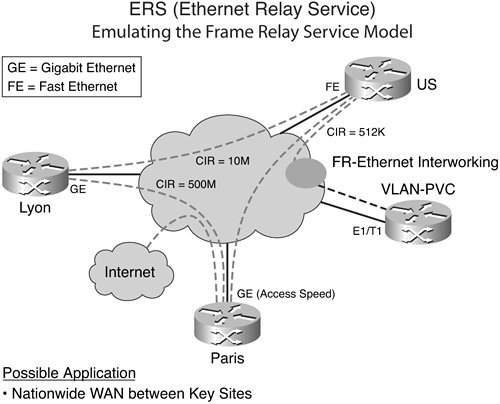MPLS and Next-Generation Networks: Foundations for NGN and Enterprise Virtualization
| Layer 2 service types include private circuit constructs: Frame Relay/ATM and emerging Ethernet. However, the use of XoverMPLS, where X is a Layer 2 construct such as Frame Relay, ATM, or Ethernet that is used to create Layer 2 VPNs for like-to-like or any-to-any implementations, is growing. This section describes various Layer 2 services available to customers. Private circuit mechanisms typically are delivered over SONET/SDH and have been popular for the past several years. The reliability inherent in SONET/SDH is due to the automatic protection switching (APS) element, which provides recovery within 50 milliseconds. The lack of bandwidth flexibility actually makes a private circuit service less interesting for customers today because they must select between a fixed bandwidth rate, such as T1 (1.5 Mbit/s) and T3 (45 Mbit/s) in North America and E1 (2 Mbit/s and E3 (34 Mbit/s) in Europe and elsewhere internationally. The bandwidth and price differences are so significant between T1/T3 and E1/E3 that customers tend to remain with their T1/E1 links and seek ways to reduce usage on these links. More important is that an equipment upgrade is required for both the service provider and the customer to increase from one rate to another. In a Layer 3 MPLS VPN environment, the average port speed can be less than 1 Mbps and most leased line access is purchased as fractional T1/E1. This is where the so-called Next-Generation SDH/SONET service becomes interesting for both the service provider and the customer to deliver what the Metro Ethernet Forum (MEF) has termed Ethernet Private Line capability. This involves circuits with Ethernet interfaces by which a customer can subscribe to high bandwidth at rates of 1 Gbit/s or higher; additionally, an upgrade can be implemented via software instead of hardware. Ethernet Services
Three types of Ethernet services are relevant to our discussion: Ethernet Private Line (EPL) is a point-to-point dedicated bandwidth service for customers; Ethernet Wire Service (EWS) is a point-to-point shared bandwidth service; and Ethernet Relay Service (ERS) is a point-to-multipoint service delivery that can integrate very well with Ethernet Access and Layer 3 services. Figure 2-1 depicts ERS, which fundamentally emulates Frame Relay. Frame Relay works on the principle of a permanent virtual circuit (PVC) being a logical connection, where the end points and a stated bandwidth called a committed information rate (CIR) are defined to the Frame Relay network devices. The bandwidth can not exceed the possible physical bandwidth. The equivalent attribute in an ERS is a VLAN-CIR-burst where the service provider specifies a VLAN ID that is similar to a Frame Relay data link connection identifier (DLCI), which is used to identify a unique virtual point-to-point connection. The customer premise equipment (CPE) is a router that could be provisioned by the service provider. The bandwidth can be complementary to Frame Relay or ATM and priced on a pervirtual circuit basis (origin-destination). Service interworking capabilityfor example, Ethernet to Frame Relay or ATMcan be implemented by the service provider. Figure 2-1. Ethernet Relay Service
A multipoint-to-multipoint service is possible via Ethernet Private Ring (EPR), which integrates well with Ethernet Access and Layer 3 services such as ERS. EPR provides dedicated bandwidth similar to EPL. Figure 2-2 summarizes the EPR service attributes, such as dedicated bandwidth for a single customer's site, which can be based on combined time-division multiplexer (TDM) ring processor recovery (RPR) mechanisms. A single physical interface reaches all sites, and the customer assigns the VLAN IDs. The CPE is a router or bridge, and the pricing can be per site and per circuit speed. The service price can be lower than a point-to-point SDH private line and Ethernet private line. Figure 2-2. Ethernet Private Ring
Ethernet Multipoint Service (EMS) is commonly referred to as a virtual private LAN service (VPLS) and extends service to shared bandwidth. Ethernet Relay Multipoint Service (ERMS) provides similar capability, but like EWS and EPR, it integrates well with Ethernet Access and Layer 3 services. Figure 2-3 details the EMS service attributes that are common in this service deployment. Key attributes of ERMS include any-to-any connectivity at Layer 2. The service provider network learns the customer MAC addresses, the customer assigns VLAN IDs, and the CPE can be a router or a bridge. The service pricing is per access and might require MAN-WAN rate limiting. Interworking is via Ethernet over X, where X can be Frame Relay or xDSL, for example. Figure 2-3. Ethernet Multipoint Service
Figure 2-4 summarizes these service constructs. Figure 2-4. Ethernet-Based VPN Services: Layer 1 and Layer 2 Services + Layer 3 Access
|
